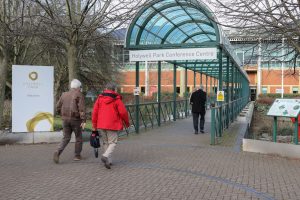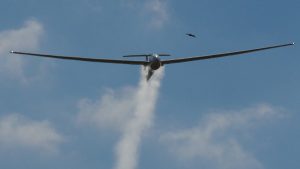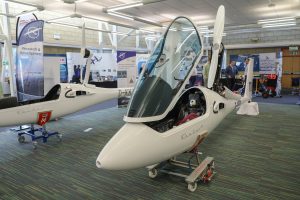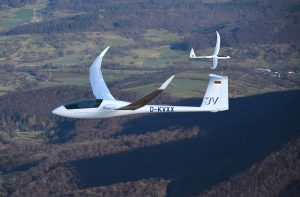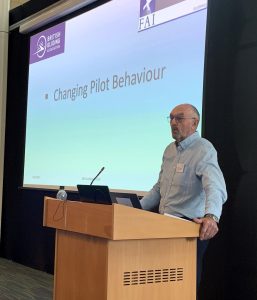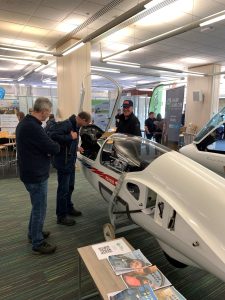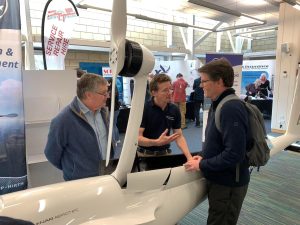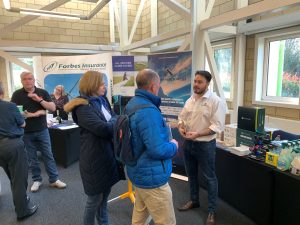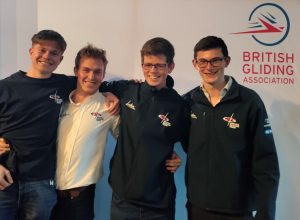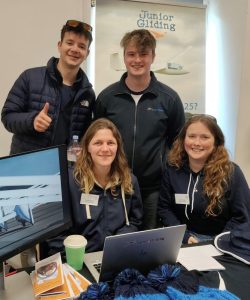BGA Conference 2024 – report
FOR the second year running, the Loughborough University Campus provided the backdrop for the BGA conference, which was held under a beautiful blue winter sky at the Holywell Park Conference Centre on 24 February. The annual awards dinner took place at the nearby Burleigh Court Hotel. The BGA office team again delivered a well organised and supported event.
Ahead of the main conference, two one-hour events took place in parallel; an inclusivity workshop led by Women’s Advocate Yvonne Elliott, and a Revolution of the Glider Cockpit workshop by LX Navigation. The main conference programme, which along with a supply of warm BGA logoed snoods was supported by Sydney Charles Insurance. The conference opened with an introduction by recently elected BGA Chair George Metcalfe who welcomed everyone including guests and trade exhibitors.
Pete Stratten presented an update on ‘Fit for the Future’, which is a series of projects to assist the delivery of BGA strategy aims, which are currently subject to a review. He went on to note how BGA volunteers, staff and contractors continue to support those managing clubs, provide services to individuals as well as support club initiatives on behalf of their members, and protect airfields and
access to airspace. Noting that BGA works with others, including GA partners as well as regulators and Government, Pete considered several hot topics. Keeping gliding fun includes effective instruction of new pilots, staying in practice, all following safe launching guidance, and careful preparation for flight, including positive checks as part of the daily inspection. Airspace modernisation of the upper and lower airspace is necessary, complex, and fraught with risks, and BGA is engaging. Noting that drones will be part of the future in lower airspace, it was noted that again BGA is engaging, and that CAA would be speaking on that topic later in the day. In finishing the airspace theme, all pilots were encouraged to understand airspace rules, consider other airspace users, and read NOTAMs before flight.
Moving on to maintenance, the national shortage of all aircraft licensed engineers was noted. It was highlighted that the 340 Part66L licensed BGA inspectors certify and that glider owners should understand and, where capable, make best use of pilot owner maintenance. In an update on Part66L licensing, it was noted that at long last the CAA has accepted that there are problems with their Part66L exams and progress is being made in revising the exams with the support of the BGA CTO
and an experienced BGA volunteer. Moving onto pilot licensing, the deadline for needing an SPL of September 2025 was highlighted at which point those still under training at that point will have their achieved training recognised. The CAA’s licensing simplification project inputs from the sailplane working group were summarised, including seeking retention of a basic instructor rating. Referring to inclusivity, Pete highlighted that less than 8% of glider pilots are women and that gliding, like all of aviation, has some way to go in achieving a reasonable gender balance. The BGA’s inclusivity initiative has proposed a National Women’s Go Gliding Weekend delivered by clubs on the 27th and 28th of April, and at the time of the conference 22 clubs had confirmed involvement, with more showing interest. Pete then provided an update on recent Ted Lys Trust awards supporting various pilot development opportunities, and the generously donated Royal Air Squadron bursaries supporting young instructor training during 2024.
The BGA medal was awarded to Andy Perkins, who has rendered exceptional service to the BGA over many years. As Andy had been called into work and was unable to attend the conference, a presentation will be made at a future date. BGA Diplomas were presented by George Metcalfe to Steve Thomson (Yorkshire GC), Pete Hardingham (Peterborough & Spalding GC), Paul Howard (The Gliding Centre), Finn and Lorna Sleigh (Cambridge GC), Richard Fitch (Surrey Hills GC), Mike Jenks (Bath, Wilts and N Dorset GC), David Hertzberg (Essex GC), Tony Smith (BGA), Mark Recht (Deeside GC), Competition Enterprise, and Peter Warren (Devon and Somerset GC). The Bill Scull Safety Award was presented to Edward Lockhart (Lasham GS). The Caroline Award was presented to Sarah Bellamy (Buckminster GC). The AJ Gallagher Instructor of the Year Award was presented to Peter Howarth (Dartmoor GC). The RAeC Awards for 2023 were detailed: Silver Medal – Tom Arscott, Silver Medal – Andy Perkins, Bronze Medal – Simon Adlard, Bronze Medal – Dave Latimer, Certificate of Merit – Tim Freegarde, Certificate of Merit – Liz Pike, Certificate of Merit – Max Kirschner, Norton Griffiths Challenge Trophy – Jon Gatfield, Old and Bold Trophy – Ben Bennett, Presidents Breitling Trophy – Amelia Richardson. The FAI Pelagia Majewska Medal had previously been awarded to Liz Sparrow. Congratulations to all!
The day progressed with plenty of opportunity to browse the wide range of technology and other gliding -related goodies available for sale, or to view and discuss the gliders that their owners had kindly brought along for the day including a Ventus 3E supplied by Schempp Hirth, a Ventus 3M supplied by Southern Sailplanes, and a beautiful K-21b supplied by Midland GC, which was equipped with a hand rudder option.
A variety of speakers provided fascinating talks throughout the day. Matthew Day led on some prepared questions and answers describing key insurance perspectives, including the wider aviation insurance picture and advice such as that owners should speak to their brokers about any potential claims even if damage is not immediately obvious. He highlighted a takeaway safety message card supported by AJ Gallagher. Brian Spreckley used his deep experience of competition flying to clearly describe how even the best pilots are unconsciously responsible for increasing collision risk and benefit from and usually respond well to being coached about it. He went on to describe a proximity analysis tool used in international competition safety awareness that should also be available for use in helping UK competition pilots also change their behaviour in busy thermals.
After lunch, Steve Jarvis took to floor and held everyone’s attention by explaining why even the most experienced pilots miss things even when they think they are getting it right. Steve’s takeaways highlighted the need for all pilots to be aware of their hard-wired human shortcomings, to be diligent about checks, and have a strategy for re-checking that recognises that all pilots think they’ve got it right but frequently have not. Colin Chesterton and Emma Simpson from the CAA’s Airspace Modernisation Delivery team described their team, which includes a well-known LS4 pilot, emerging challenges in integrating the growing drone industry into busy airspace, likely developments around electronic conspicuity as an airspace access enabler, noted the trials, structures and approaches being developed to support changes while minimising the impact on existing airspace users, and highlighted the need for ongoing close engagement with GA including gliding.
Following the afternoon coffee break LX Nav’s Erazem Polutnik talked about the advantages of real time wind indication in your glider, with the development, usage, and future of HAWK. Developed by Heinrich Meyr and Peng Huang, instant results are provided in all three axis using sensor fusion and advanced digital signal processing. It is supported on the S10/S100 vario.
Schempp-Hirth’s Benjamin Neglais then introduced delegates to the Ventus E electric self-launcher concept. With a history of producing 110 gliders with an electro engine, mainly as a sustainer, Benjamin explained why the Ventus Sport platform had been chosen to develop as a self-launcher. A wooden prototype was used to provide valuable feedback to the 3D team. SOLO designed the two-stroke engines of Schempp-Hirth’s self-launching models for retractable engine systems. Batteries are installed in the fuselage, which ‘future proofs’ for evolution of batteries. It is hoped that the flight test will take place before AERO Friedrichshafen in April. Benjamin ended his talk paying tribute to ‘Mr SOLO’, Wolfgang Emmerich, who died at the beginning of the year. He also outlined the retrofit offers now available for other Schempp-Hirth gliders.
Toby Freeland brought home a Silver medal in the Club Class at the 2023 Junior Worlds in Denmark. Using a ‘five steps to a Gold medal’ model, Toby emphasised a gliding development plan and the need to put in the effort for results (his choice of university was based on opportunities to glide). He ended with a plea for experienced pilots to offer a cross-country seat for coaching, and for gliders to be loaned to juniors. George White continued the junior gliding theme with an interesting talk on a young pilot’s journey of competitions and instructing. George talked about how he became an instructor and encouraged others to do the same. The day was closed by BGA chair George Metcalfe, who thanked all who attended, the speakers, the sponsors, the exhibitors, and Liz Pike, who arranged and managed the conference with the support of her BGA office colleagues.
The evening dinner and awards event, which was supported by Navboys, included a presentation by Jake Brattle to Shaun Lapworth recognising his support, followed by the presentation of BGA trophies by RAeC Secretary Dave Phipps, where amazing flights and competition successes during 2023 were recognised and applauded, including Tom Arscott’s truly outstanding achievement as World Champion in the Standard Class. As the evening turned into a hazy night, junior pilots (over-18, naturally) revved up the already great atmosphere, and the last finishers crossed the line at dawn
